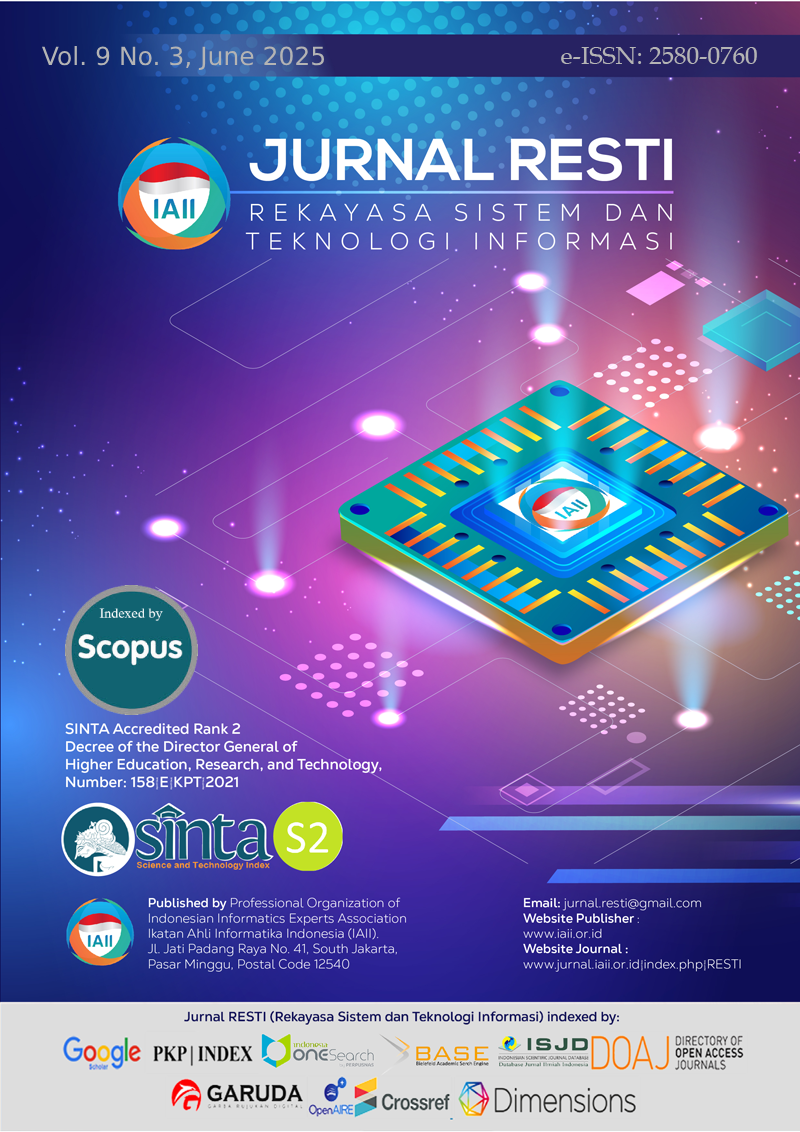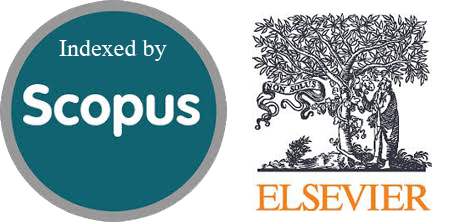Prediction of Financial Distress in Retail Companies Using Long-Short Term Memory (LSTM)
Abstract
Financial distress is a condition in which an entity struggles to meet its debt and operating obligations.. Financial distress can lead to bankruptcy or company closure if corrective action is not taken. This study aims to forecast financial distress in retail companies by utilizing key financial ratios, including Total Asset Turnover (TATO), Current Ratio (CR), Return on Assets (ROA), and Debt-to-Equity Ratio (DER). The analysis is based on secondary data from Indonesian retail companies listed on the Indonesia Stock Exchange (IDX) during the 2022–2024 period. The dataset exhibited missing values and class imbalance, which were addressed using mean imputation and the Synthetic Minority Oversampling Technique (SMOTE), respectivelyTo perform predictions, a Long Short-Term Memory (LSTM) model was implemented. The integration of SMOTE contributed to enhanced detection of the minority class; however, it was accompanied by a slight reduction in overall predictive accuracy. The model demonstrated a performance accuracy of 86%, with a recall rate of 85%, a precision of 100%, and an F1-score of 92%.
Downloads
References
A. A. Lestari and D. E. Kusrini, “Analisis Financial Distress Menggunakan Regresi Data Panel,” Semin. Nas. Off. Stat., vol. 2021, no. 1, pp. 264–273, 2021, doi: 10.34123/semnasoffstat.v2021i1.855.
A. Larasati and A. Jayanih, “The Influence of Company Size, Company Growth and Profitability on Financial Distress,” Scientia, vol. 2, no. 1, pp. 16–23, 2023, doi: 10.51773/sssh.v2i1.128.
N. B. M. Maghrebi, “Preliminary Evidence on the Relation between Economic Uncertainty, Financial Stress and Liquidity Risk,” Wakayama Econ. Rev., vol. 408, pp. 17–34, 2022, [Online]. Available: https://repository.center.wakayama-u.ac.jp/4833
P. R. Masdiantini and N. M. S. Warasniasih, “Laporan Keuangan dan Prediksi Kebangkrutan Perusahaan,” J. Ilm. Akunt., vol. 5, no. 1, p. 196, 2020, doi: 10.23887/jia.v5i1.25119.
R. M. E. Lestari, M. Situmorang, M. I. P. Pratama, and A. T. Bon, “Financial distress analysis using altman (Z-score), springate (S-Score), zmijewski (X-Score), and grover (G-Score) models in the tourism, hospitality and restaurant subsectors listed on the Indonesia stock exchange period 2015-2019,” Proc. Int. Conf. Ind. Eng. Oper. Manag., pp. 4249–4259, 2021, doi: 10.46254/an11.20210755.
N. Bărbuță-Mișu and M. Madaleno, “Assessment of Bankruptcy Risk of Large Companies: European Countries Evolution Analysis,” J. Risk Financ. Manag., vol. 13, no. 3, 2020, doi: 10.3390/jrfm13030058.
A. Mehmood and F. De Luca, “Financial distress prediction in private firms: developing a model for troubled debt restructuring,” J. Appl. Account. Res., 2023, doi: 10.1108/JAAR-12-2022-0325.
H. Sasongko, A. Fajar Ilmiyono, and A. Tiaranti, “Financial Ratios and Financial Distress in Retail Trade Sector Companies,” JIAFE (Jurnal Ilm. Akunt. Fak. Ekon., vol. 07, no. 01, pp. 63–72, 2021, doi: 10.34204/jiafe.v7i1.3380.
T. Zakiyah and W. Windasari, “Implementasi Model Finansial Distres Pada Perusahaan Manufaktur Yang Terdaftar di IDX Tahun 2015-2017,” J. Ilm. Akunt. dan Keuang., vol. 9, no. 1, pp. 61–74, Jan. 2020, doi: 10.32639/jiak.v9i1.330.
D. Nurfauziyyah and A. I. Muslim, “Literature Review tentang Financial Distress yang Terbit di Jurnal Sinta,” vol. 9, no. 02, pp. 225–240, 2024.
M. N. Syaifudin, “Perbandingan Analisis Prediksi Kebangkrutan Menggunakan Model Altman dengan Ukuran Perusahaan Sebagai Variabel Penjelas pada Perusahaan Industri Keuangan Bank yang Terdaftar di Bursa Efek Indonesia Indonesia Periode 2010-2012,” J. Mhs. Univ. Negeri Surabaya, pp. 1–25, 2012.
D. Wu, X. Ma, and D. L. Olson, “Financial distress prediction using integrated Z-score and multilayer perceptron neural networks,” Decis. Support Syst., vol. 159, no. March, p. 113814, 2022, doi: 10.1016/j.dss.2022.113814.
M. El-Bannany, M. Sreedharan, and A. M. Khedr, “A robust deep learning model for financial distress prediction,” Int. J. Adv. Comput. Sci. Appl., no. 2, pp. 170–175, 2020, doi: 10.14569/ijacsa.2020.0110222.
F. M. Shiri, T. Perumal, N. Mustapha, and R. Mohamed, “A Comprehensive Overview and Comparative Analysis on Deep Learning Models: CNN, RNN, LSTM, GRU,” no. September, 2023, doi: 10.13140/RG.2.2.11938.81609.
S. S. Nurashila, F. Hamami, and T. F. Kusumasari, “Perbandingan Kinerja Algoritma Recurrent Neural Network (Rnn) Dan Long Short-Term Memory (Lstm): Studi Kasus Prediksi Kemacetan Lalu Lintas Jaringan Pt Xyz,” JIPI (Jurnal Ilm. Penelit. dan Pembelajaran Inform., vol. 8, no. 3, pp. 864–877, 2023, doi: 10.29100/jipi.v8i3.3961.
M. Laksmiwati, A. Mappadang, A. Indrabudiman, and V. G. Riza, “Determination of Financial Performance on Prediction Financial Distress,” Asian J. Econ. Bus. Account., no. December 2021, pp. 46–57, 2021, doi: 10.9734/ajeba/2021/v21i2230523.
A. Rabbani, N. A. Achsani, and T. Andati, “Financial Distress Analysis of Delisted Companies on Indonesian Stock Exchange for Period of 2013-2019,” Russ. J. Agric. Socio-Economic Sci., vol. 119, no. 11, pp. 11–18, 2021, doi: 10.18551/rjoas.2021-11.02.
G. Difoasih and P. Sihombing, “Analysis of The Effect of Financial Performance, Board Gender Diversity and CSR on Financial Distress in Tourism on the IDX,” Int. J. Innov. Sci. Res. Technol., vol. 8, no. 12, 2023.
M. Marcellino, G. Castelblanco, and A. De Marco, “Multiple linear regression model for project’s risk profile and DSCR,” AIP Conf. Proc., vol. 2928, no. 1, 2023, doi: 10.1063/5.0171033.
J. Ruster, “Mitigating Commercial Risks in Project Finance. Public Policy for Private Sector,” in Public Policy for Private Sector, New York, 1996.
M. R. R. Allam and A. T. Wibowo, “Klasifikasi Genus Tanaman Anggrek berdasarkan Citra Kuntum Bunga Menggunakan Metode Convolutional Neural Network (CNN),” e-Proceeding Eng., vol. 7, no. 2, pp. 8015–8023, 2020, [Online]. Available: https://www.programmersought.com/article/3724355693/
S. Ghimire, R. C. Deo, D. Casillas-Pérez, S. Salcedo-Sanz, E. Sharma, and M. Ali, “Deep learning CNN-LSTM-MLP hybrid fusion model for feature optimizations and daily solar radiation prediction,” Meas. J. Int. Meas. Confed., vol. 202, no. April, p. 111759, 2022, doi: 10.1016/j.measurement.2022.111759.
A. Shafi, S., Assad, “Exploring the Relationship Between Learning Rate, Batch Size, and Epochs in Deep Learning: An Experimental Study,” in Soft Computing for Problem Solving, 2023, pp. 201–209. doi: https://doi.org/10.1007/978-981-19-6525-8_16.
D. F. Santosa, L. Anggraeni, and K. Pranowo, “Determinan Financial Distress Perusahaan Subsektor Ritel Di Bursa Efek Indonesia,” J. Apl. Bisnis dan Manaj., vol. 6, no. 1, pp. 128–141, 2020, doi: 10.17358/jabm.6.1.128.
S. J. Pipin, R. Purba, and H. Kurniawan, “Prediksi Saham Menggunakan Recurrent Neural Network (RNN-LSTM) dengan Optimasi Adaptive Moment Estimation,” J. Comput. Syst. Informatics, vol. 4, no. 4, pp. 806–815, 2023, doi: 10.47065/josyc.v4i4.4014.
N. Istiana and A. Mustafiril, “Perbandingan Metode Klasifikasi pada Data dengan Imbalance Class dan Missing Value,” J. Inform., vol. 10, no. 2, pp. 101–108, 2023, doi: 10.31294/inf.v10i2.15540.
Copyright (c) 2025 Jurnal RESTI (Rekayasa Sistem dan Teknologi Informasi)

This work is licensed under a Creative Commons Attribution 4.0 International License.
Copyright in each article belongs to the author
- The author acknowledges that the RESTI Journal (System Engineering and Information Technology) is the first publisher to publish with a license Creative Commons Attribution 4.0 International License.
- Authors can enter writing separately, arrange the non-exclusive distribution of manuscripts that have been published in this journal into other versions (eg sent to the author's institutional repository, publication in a book, etc.), by acknowledging that the manuscript has been published for the first time in the RESTI (Rekayasa Sistem dan Teknologi Informasi) journal ;








